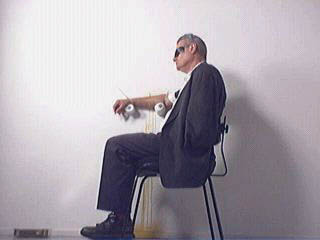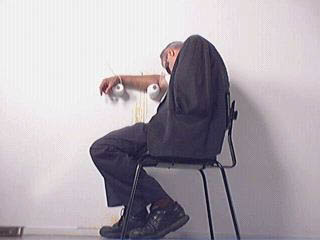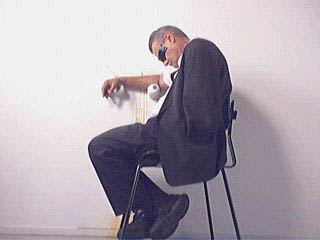Mike Parr: internet performance
Adam Geczy

Mike Parr, Malevich
It is not always easy explaining the difference between ‘seeing’ and ‘watching’ to a non-native speaker or child. Television is ‘watched’, although movies, no matter where they are, are ‘seen’; in a cinema you operatively ‘go to see’ a film, as you might go to see a performance, as opposed to just ‘going to’ a concert. Sometimes choosing from these differences is as confusing as deciding whether soup is either eaten or drunk—did I ‘see’ or ‘hear’ that concert I went to last night? When defining media, we have to sort out the relationship between context, the 5 senses and intellection. This may be true for all things perceived, but in the case of media, these basic human factors that transmit and support information are visibly in play—and at stake. While such distinctions as watching and seeing are elusively, perhaps even cunningly, embedded within our language, they have been shaped into persuasive axioms by Marshall McLuhan in juxtapositions like ‘hot’ and ‘cold’ media; television for instance is cold and film hot, measured by the amount of input the viewer has to make. Whether you are an adherent or not, this is media doxa; what I would like to do here is begin a discussion about where we critically situate performance art projected over the internet.

Mike Parr, Malevich
From May 3 to 5 this year Mike Parr staged his performance Malevich at Artspace. He nailed his arm to the wall and stayed there with tape over his eyes, drinking, not eating, urinating onto the floor through his pants and deprived of all sensory stimulation short of the goings-on around him. The performance was broadcast over the web and in the first 24 hours alone received more than 250,000 hits. At any time, day or night, all you had to do was boot up your computer, log on to the internet, call up the address, and there he was, a few instants away from present time. He had already essayed something like this a year before. For Water from the mouth, 10 days x 24 hours, Parr sequestered himself in a room, again at Artspace, without food for the said duration. Thanks to webcam, anyone could witness this orgy of privation, at any time.
Performances such as these, which are dramatic in the way they both formalise and ritualise discomfort, as well as frame the scene of deprivation, have a distinctly different effect when they appear at home on the screen. What is most disturbing is the simultaneity of impotent deadness and uncomfortable proximity; the world wide web has on the one hand reduced this insane feat of bodily and psychological distension to the median level of cybernetic sameness, and on the other brings the performance so close to you and your living space that it invades it, infiltrates it. Just think: you can watch the body perform, and suffer, do whatever it is doing or not doing while you do the housework, talk to a friend, fix a bicycle, enjoy a bottle of vintage wine—or have sex. For the webcast performance, the cliche of being both everywhere and nowhere at once has never been so true.

Mike Parr, Malevich
Traditionally, performance art is about absolute presence. As an art form it can be extremely supple, capable of drawing from standard practices of painting and sculpture—including those age-old conventions of the pictorial tableau and the tableau vivant—while possibly availing itself of literature and music, and of course every form of theatre, from ancient to modern. Structurally and conceptually, performance art can be reduced to 2 often interrelating domains—improvisation and orchestration. History has seen the body reduced to a mere site of mechanistic forces, or on the other extreme elevated to hyper-sensory heights. One says that my body, however special it is to me personally, is still just matter, the other says that it is unrealistic to exclude subjectivity. But when the dynamic force, that presentness, of a performance is mediated via something like a screen, the differences tend to be flattened, the viewer becomes more of a voyeur, protected by distance, and the spectacle becomes more horror-cabinet, or more hysterical, or just innocuously cute.
The origin of performance art can be located in 1917 in Zurich at the Cabaret Voltaire, where Hugo Ball, his partner Emmy Hennings and several other notable Dadaists, spouted nonsense verse to accompany nonsense acts to protest the Great War and the preciousness of art in general: no more cute art in frames, no more static art that only makes the philistines richer. From its beginnings, then, a critical part of the content of performance art has been its ephemerality. Once performed, or in fact at any given moment during the performance, it can never be the same again.
This element of sovereign uniqueness brought the genre a specificity that seemed a natural and necessary strategy during the protest era of the late 60s and 70s. Gleaning from all kinds of foreign rituals, violent and conciliatory, performance art suited an artist with a political edge to the nth degree. A performance could not be bought by a goon in a suit. But photos could, and artists need to survive. Since the 70s a transition gradually took place where the photograph as mere record became a substantive genre, today exhibited alongside other forms of photography. This modification has vitiated, as well as invigorated performance art. Crucially, though, the assimilation of dynamic, unrepeatable performance art back into the market of static commodities spelled its critical death. While performativity is universally understood as a vital component of all artistic labour, and is characteristically transitional, anticipatory and impalpable, performance art is now very much a genre unto its own, with its own history and major exponents, and can no longer claim to be the rogue art form it once claimed to be.
Webcast performance forces the whole concept of presence to be rethought. Its closest relative is of course the web broadcast, where the idea is to present the events as they occur. The delay is something of an issue, though, with performance art. We might say that the hotness of the performed event as it once was, in all its dynamism and physicality, has become cool, distant and, in the manner of the idea of cool, inviolable. Gone is the possibility of disrupting the performer, to spit, to shout and to yell abuse. In traditional performance art the performer actively acts out him or herself, engendering a feedback that radicalises the role of subjectivity and self. That thrilling all-at-onceness of so many factors is magisterially displaced when projected over the internet.
The primal, fundamental interactivity of being consciously in the presence of an event changes into a different form of interactivity, having more in common with that of the telephone, because what you as a viewer are doing is ringing up the performance, ringing up that not-quantified presence. And what you get is some vague cybernetic echo. Until systems become more powerful in the future, the webcast animated image is of a figure (or whatever) whose movements at intervals shift slowly, stroboscopically, as the screen recalibrates. This visual reverb can be curiously poetic, and increases the isolated pathos of the performing figure, as the digital apparatus seems to convulse together (in reply to?) the movements of the performance artist.
Internet performance art is located mid-way between the telephone and television. In stock McLuhan, the former is hot, the latter cold. The telephone is still the most interactive instrument we know, few are capable of resisting its ring, and we are all guilty of staying on the telephone when there is no more left to say. Cool television is the most inscrutable medium in the world; it goes on and on regardless of what you do. You can have it on all day, and it chatters on aimlessly unperturbed. It does not need interaction in any form; it does not want thought. It relishes disengagement, pure vegetation.
So when Parr locks himself in a room for 10 days, or nails his arm to the wall, you are welcome to ‘phone in’, and the body dumbly replies by stating that is where it is, then and there. You are present to your own watching, and by booting up and hitting, you are part of the performance. What has changed is that once performance art wanted to restore ritual—pure integration and absolute interactivity—to the Western capitalist consciousness, and now the most widespread ritualisation the world has ever known is interacting via machines on the internet. Performance art over the internet must also deal with having already been surpassed by chat-rooms, which are more about the cheap thrill of interaction than actual communication.
As Parr’s recent performances have shown, the only way to counter the increasing spread of lobotomised drivel and ill-considered noise everywhere is not through horror but pathos. And these days, the realms of pathos are not just that of the inner, tortured plight of the subject, they have to be matched by the sometimes unthinkable terrible plight of others. By default or by necessity, internet performance art has the political body (and the body politic) insinuated into it like never before. Internet performance art has transformed surveillance and technological imprisonment into a genre that is as medieval as it is futuristic. It is no accident, then, that a performance like Parr’s Malevich, which deals with Australia’s current racial shame, incorporates a third party: there is the performer (the ersatz victim), there is you the sporadic, interactive voyeur, and there is the true victim, deprived of the luxuries of performing or interacting.
Adam Geczy is collaborating with Mike Parr on a series of performance-installations to tour nationally 2003-4.
RealTime issue #52 Dec-Jan 2002 pg. 28






